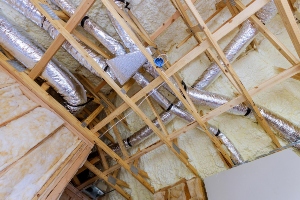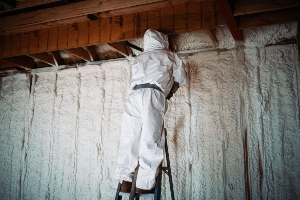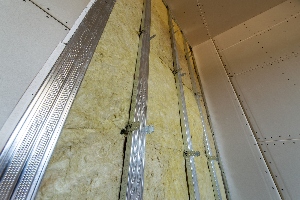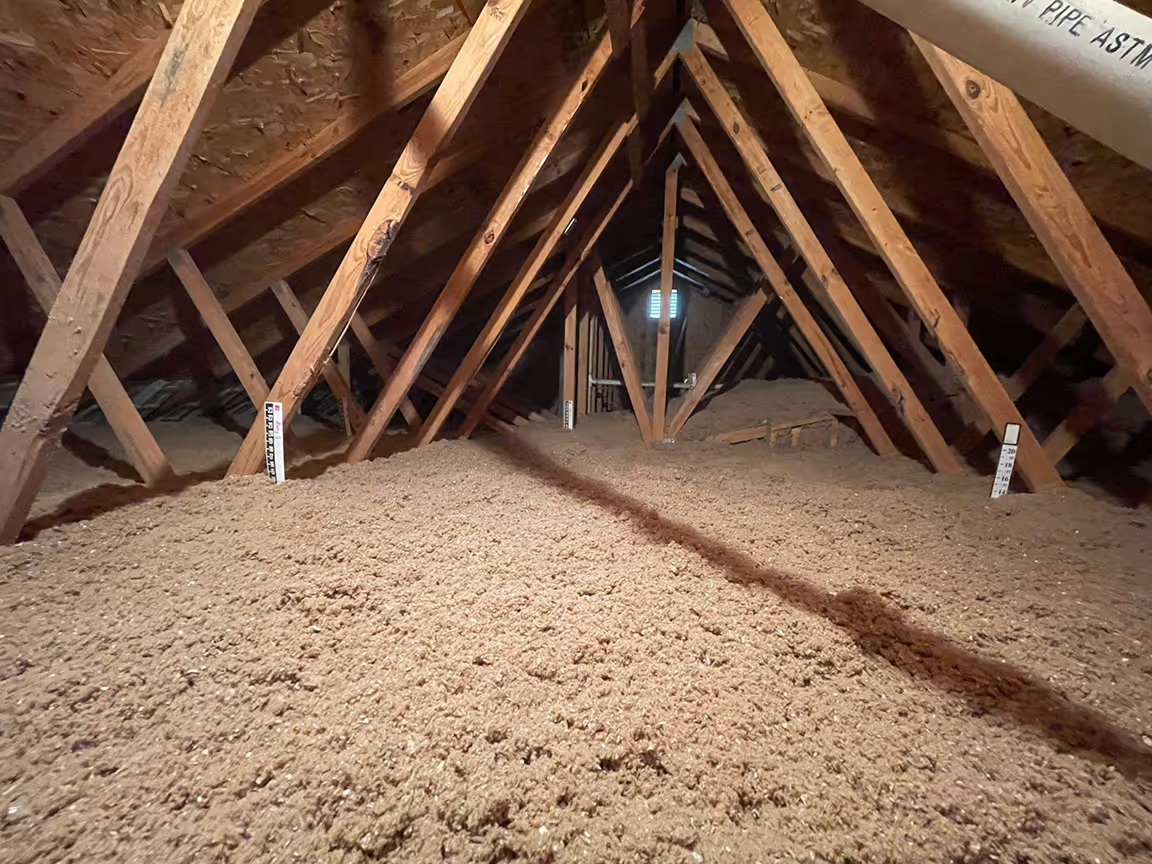Many homeowners think attic insulation only matters in winter, but that’s a costly mistake. A well-insulated attic plays a key role in keeping our homes comfortable and energy-efficient year-round.
The EPA reports that proper attic insulation can reduce yearly heating and cooling costs by 15%, making it one of the most effective ways to lower energy bills. When heat moves up through ceilings in winter or enters through roofs in summer, it forces HVAC systems to work harder than needed.
Around 90% of homes in America don’t have enough insulation, and this gap in protection leads to wasted energy and higher utility costs every month. Good attic insulation creates a barrier that keeps heated or cooled air where it’s needed.
Understanding Attic Insulation and Energy Efficiency
Good attic insulation paired with proper air sealing can cut heating and cooling costs by up to 15%. The right materials and installation methods make a significant difference in home comfort and energy savings.
The Role of R-Value in Insulation
R-values measure how well insulation resists heat flow, and a higher R-value means better insulation performance. Different climate zones need different R-values. Northern areas typically need R-49 to R-60, while southern regions might only need R-30 to R-38. The thickness of the insulation affects its R-value. More inches generally means better protection, but compression can reduce effectiveness.
Types of Attic Insulation Materials
Fiberglass Batts
- The most common and cost-effective
- R-value of 13-30 depending on thickness
- Cost: $0.20-$1.00 per square foot
Blown-in Fiberglass or Cellulose
- Fills gaps and irregular spaces well
- Easy to add over existing insulation
- Better coverage than batts
Spray Foam
- Highest R-value per inch
- Creates an air seal while insulating
- More expensive but very effective
Benefits of Air Sealing Alongside Insulation
Air leaks can waste up to 30% of your heating and cooling energy, Sealing these gaps makes insulation work better. Seal air leaks before adding new insulation, as this combination provides the best energy savings and comfort improvements. Proper air sealing also helps prevent moisture problems in your attic, stops drafts, and keeps indoor temperatures more stable.
Common leak spots include:
- Attic hatches
- Wire holes
- Plumbing vents
- Light fixtures
Strategies for Reducing Energy Bills with Attic Insulation
Proper attic insulation techniques can cut energy costs by 15% or more when implemented correctly. Smart insulation choices and careful installation make a big difference in keeping heating and cooling costs down.
Preventing Heat Loss and Heat Gain
Start with R-30 to R-60-rated insulation material based on your climate zone. Installing insulation between floor joists creates a thermal boundary that stops warm air from escaping in winter. You can add an extra layer across the joists for better coverage.
Additionally, a radiant barrier or reflective insulation on the underside of the roof helps block summer heat from entering your living space. This works best in hot climates with lots of sunny days.
Key insulation zones:
- Attic floor
- Roof rafters
- Knee walls
- Access hatches
Recommended R-Values:
- R-30 to R-60 for cold climates
- R-30 to R-49 for moderate climates
- R-19 to R-38 for warm climates
Tackling Moisture Control and Ventilation
Good airflow prevents moisture buildup that can reduce insulation effectiveness, and proper ventilation requires both intake and exhaust vents. We suggest installing vent baffles to maintain airflow paths between the insulation and the roof deck. This keeps the ventilation channels clear and working properly.
Essential ventilation elements:
- Soffit vents for air intake
- Ridge vents for exhaust
- Gable vents for cross-ventilation
- Vapor barriers to block moisture
Addressing Energy Loss Through Air Leaks
Sealing air leaks is crucial before adding new insulation, as small gaps around pipes, wires, and fixtures let expensive conditioned air escape. Use caulk for small gaps and expanding foam for larger openings. Weather-stripping around the attic access hatch creates an airtight seal.
Common leak points to check:
- Light fixtures
- Plumbing stacks
- Electrical boxes
- Attic access doors
- Chimney penetrations
Consider a professional energy audit to find hidden leaks. Experts can use an infrared camera to scan the area, revealing where air is escaping through walls and ceilings.
Practical Considerations for Attic Insulation Installation
Installing attic insulation requires careful planning and attention to detail. The right materials and proper installation make a big difference in energy savings.
Selecting the Right Insulation Type
- Fiberglass batts are easy to handle and cost-effective, coming in pre-cut sizes that fit between standard joists and rafters.
- Spray foam creates an airtight seal but costs more than other options. It works great for oddly shaped spaces and around obstacles.
- Cellulose is made from recycled paper products and can be blown into place. It fills gaps well and provides good sound dampening.
Professional Installation vs. DIY
Professional installation ensures proper coverage and ventilation, and trained installers know how to:
- Seal air leaks before adding insulation
- Install vapor barriers when needed
- Protect electrical components
- Maintain proper ventilation
DIY installation can save money but requires careful preparation. You’ll need the following for a high-quality job:
- Proper safety gear
- Basic tools
- Knowledge of electrical safety
- Understanding of vapor barriers
Upgrading Existing Insulation
Check your current insulation depth with a ruler, and if you can see floor joists, you need more insulation. Remove damaged insulation before adding new material. Also, keep vents clear and leave 3 inches of space around chimneys and recessed lights for safety. New insulation can go right over old materials if they’re:
- Clean and dry
- Free from mold
- Not compressed
- Not water-damaged
The Long-Term Impact of Attic Insulation on Home and Environment
Proper attic insulation delivers lasting benefits that extend far beyond monthly energy savings. The right insulation creates measurable value for both property owners and the planet.
Boosting Home Value and Comfort
A well-insulated attic can increase home value by 2-6%, according to real estate experts. This upgrade appeals strongly to potential buyers who want energy-efficient homes. The improved temperature control creates a more comfortable living space throughout the year. You’ll notice steadier indoor temperatures from room to room and floor to floor.
Better insulation protects against moisture damage by preventing condensation in the attic space. This helps preserve structural elements and prevents mold growth that could harm indoor air quality.
Reducing Carbon Footprint and Environmental Impact
A properly insulated home reduces greenhouse gas emissions by using less energy for heating and cooling. The average home can cut carbon emissions by 1,000 pounds yearly through quality attic insulation.
Modern insulation materials are often made from recycled content and can last 20-30 years before needing replacement. Choose eco-friendly options like cellulose made from recycled paper products.
The reduced energy demand also means power plants burn less fossil fuel to meet household needs. This creates a ripple effect of environmental benefits. Decreased energy usage helps conserve natural resources for future generations. Even small improvements in home efficiency add up to significant environmental impact when adopted widely.
Get in touch to discuss improving your home’s insulation or adding energy-efficiency upgrades to lower your bills.





